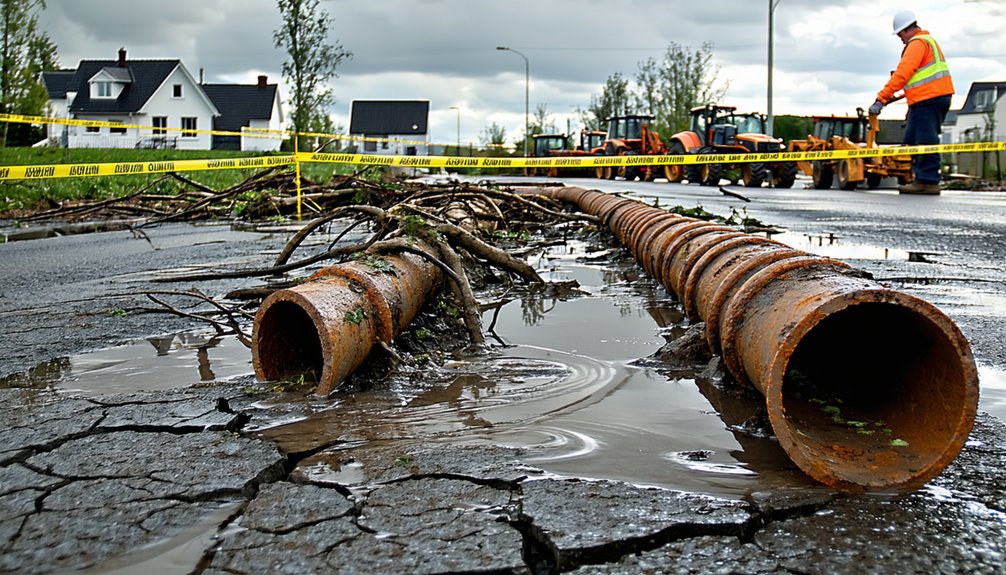Homeowners facing emergency sewer line issues have two main options: trenchless sewer line replacement and traditional excavation. Trenchless methods, such as pipe bursting and CIPP, minimize property disruption and environmental impact while offering faster, cost-effective solutions. Conversely, traditional replacement is necessary when pipes are severely damaged, allowing for all-encompassing replacement at a higher cost. Understanding these methods' advantages and specific applications can help homeowners make informed decisions regarding their plumbing needs. More details await to further clarify these options.
Trenchless Sewer Line Replacement: Advantages and Process
Although traditional sewer line replacement methods often entail extensive excavation and disruption, trenchless sewer line replacement presents a modern alternative that minimizes both environmental impact and property disturbance. Utilizing advanced techniques such as pipe bursting and CIPP (Cured-In-Place Pipe), this method allows for the installation of new pipes with limited excavation, preserving landscaping and aesthetics. The approach is remarkably faster and often serves as a cost-effective solution compared to conventional methods, considerably reducing installation times. Trenchless repairs effectively address issues like tree root infiltration and pipe corrosion, restoring the plumbing system's functionality without major disruptions. Additionally, the reduced need for extensive digging minimizes soil disposal, further mitigating environmental impact. Homeowners frequently report higher satisfaction due to the quick restoration of service and the minimal mess associated with the installation process, making trenchless sewer line replacement an appealing option in emergency situations.
Traditional Sewer Line Replacement: When It's Necessary
Trenchless sewer line replacement offers significant advantages for many plumbing issues; however, there are circumstances where traditional sewer line replacement becomes necessary. This method is essential when pipes are severely damaged due to extensive corrosion, significant misalignments, or breaks that cannot be remedied using trenchless methods. Traditional replacement requires extensive excavation, leading to landscaping disruption and potential damage to surrounding structures, making it a more invasive approach. Despite these drawbacks, it remains a viable option for compromised sewer systems that cannot accommodate trenchless technologies. Additionally, traditional techniques guarantee a thorough replacement of the entire sewer line, thereby restoring its proper function. The average cost for traditional sewer line replacement ranges from $5,000 to $8,000, influenced by factors such as material choice, accessibility, and the extent of the damage. While more time-consuming, traditional replacement serves as a necessary solution in specific, critical scenarios.
Emergency Response Services for Sewer Line Issues
When faced with sudden sewer line failures, how quickly can effective solutions be implemented? Emergency response services are critical in managing such plumbing crises. In Northern New Jersey, licensed service providers offer 24/7 emergency sewer replacement, ensuring that damaged sewer lines are addressed without delay. These services guarantee same-day dispatch of trained professionals equipped with advanced tools to tackle issues efficiently, including tree roots intrusion and urgent sewer line repairs.
- 24/7 emergency response availability
- Same-day service for critical situations
- Expert assessment using advanced equipment
- Compliance with local regulations by licensed providers
- Swift restoration of sewer functionality
Utilizing trenchless repair techniques and thorough drain cleaning methods, these professionals minimize property damage while restoring normalcy. Prompt assistance is just a call away, underscoring the importance of reliable plumbing services in emergency situations.
Frequently Asked Questions
What Is the Cheapest Way to Replace a Sewer Line?
To identify the cheapest way to replace a sewer line, one must consider cheap alternatives such as DIY methods and financing options. Local grants and insurance coverage can alleviate costs. Selecting the right material choices and exploring different excavation techniques may reduce expenses. Additionally, minimizing labor costs through competitive quotes is essential. Implementing plumbing warranties and adhering to maintenance tips can prevent future issues, ultimately saving homeowners from more significant financial burdens.
What Is a Sewer Emergency?
A sewer emergency is characterized by sewer backup causes, which include significant clogs, pipe bursts, or tree root intrusion. Homeowners must recognize signs of failure, such as multiple fixture overflows and persistent odors. Emergency plumbing tips suggest immediate action, including temporary solutions while awaiting professional help. Understanding plumbing service options and local regulations is vital. Additionally, employing sewer inspection methods and DIY troubleshooting steps can aid in identifying problems, dispelling common misconceptions regarding sewer emergencies.
Why Is Sewer Line Replacement so Expensive?
Sewer line replacement incurs significant costs due to various cost factors. Material types, such as PVC or cast iron, influence pricing, while labor expenses and inspection fees add to the overall bill. The location impact plays an essential role, as difficult access can increase labor time. Additionally, plumbing permits are often required. Emergency services may further elevate costs, though investing in quality pipe materials and advanced installation techniques can yield long-term savings.
Is Trenchless Sewer Repair Worth It?
Studies indicate that trenchless technology can reduce soil disturbance by up to 90% compared to traditional methods. The trenchless repair process offers significant time efficiency, often completed within a day, minimizing disruption to homeowners. A cost savings analysis reveals long-term durability, with new pipes lasting over 50 years. Homeowner testimonials highlight high satisfaction rates, while an environmental impact assessment underscores reduced landscaping restoration costs. Professional expertise is essential for successful implementation, emphasizing the method's overall effectiveness.



